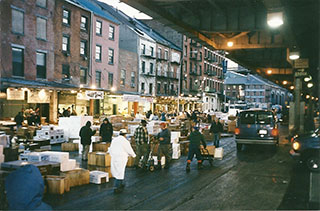A few stories above the crowd milling around Manhattan's Pier 16, ironworkers called out and clanged steel as the Fire Department City of New York prepared to christen its new fireboat.
The 66’ William M. Feehan will be stationed on the East River, ready to respond to any emergency along the redeveloping waterfront of lower Manhattan. How that neighborhood will finally take shape – and its relationship to the river that helped create it – is still in debate.
Dotted around the pier are small signs and stickers with the words “Save Our Seaport,” the motto of a band of South Street neighborhood activists who are trying to keep intact the neighborhood’s low-rise character, its 19th century brick buildings, and public access to the city’s oldest working waterfront.
They won a round this month, when the Howard Hughes Corp., the city’s chosen redeveloper, backed off its proposal for a tower as tall as 50 stories. Critics derided that idea for potentially blocking iconic views of the Brooklyn Bridge.
Fulton Fish Market in 2002. Kirk Moore photo.South Street has seen some hard years. In 2005 the fabled Fulton Fish Market was moved to Hunt’s Point in the Bronx, in the name of meeting the U.S. Food and Drug Administration’s rules for modern food handling sanitation.
After nearly 200 years on the street, the market’s departure took with it a lot of the neighborhood’s character and blue-collar panache. The New York City Economic Development Corp. began redevelopment, but that stalled in the Great Recession that was triggered a few blocks away on Wall Street in 2008.
The South Street Seaport Museum had a near-death experience when years of financial difficulties caught up with it. Then, in October 2012, Hurricane Sandy pushed the East River into the street.
Now the recovery is picking up speed. Along with rebuilding Pier 17 with a mall and theater, HHC is finishing its own Fulton Market, which as one might guess is not about fish. This summer an outdoor restaurant opened near the Pier 11 ferry terminal, and more openings are in the works.
Done right, waterfront redevelopment can bring a boost to the maritime industry generally and small passenger service in particular. Mayor Bill De Blasio’s administration has big plans for expanding inexpensive ferry routes throughout the city, and the South Street area would be one hub.
But the city’s never-ending struggle between developers and preservationists will play a role, and historically the latter tend to lose. It’s  South Street, the former Fulton Fish Market site, in 2015. Kirk Moore photo. an old story; the city’s separation from the water was part of a lament for the “Lost City” that newspaperman Pete Hamill voiced almost 30 years ago: “You can sit at the Battery and watch the ocean liners cleave through the harbor, stately and powerful among their court of tugboats, heading for berths on the North River (the reporters have arrived on the launch, with their press cards in their hats, and they are interviewing the Duke and Duchess of Windsor, or propping a movie star on top of a steamer trunk).”
South Street, the former Fulton Fish Market site, in 2015. Kirk Moore photo. an old story; the city’s separation from the water was part of a lament for the “Lost City” that newspaperman Pete Hamill voiced almost 30 years ago: “You can sit at the Battery and watch the ocean liners cleave through the harbor, stately and powerful among their court of tugboats, heading for berths on the North River (the reporters have arrived on the launch, with their press cards in their hats, and they are interviewing the Duke and Duchess of Windsor, or propping a movie star on top of a steamer trunk).”
Ongoing growth of ferry and passenger service around New York Harbor in the years since may help build a constituency for appreciating and keeping the city’s living maritime heritage.




